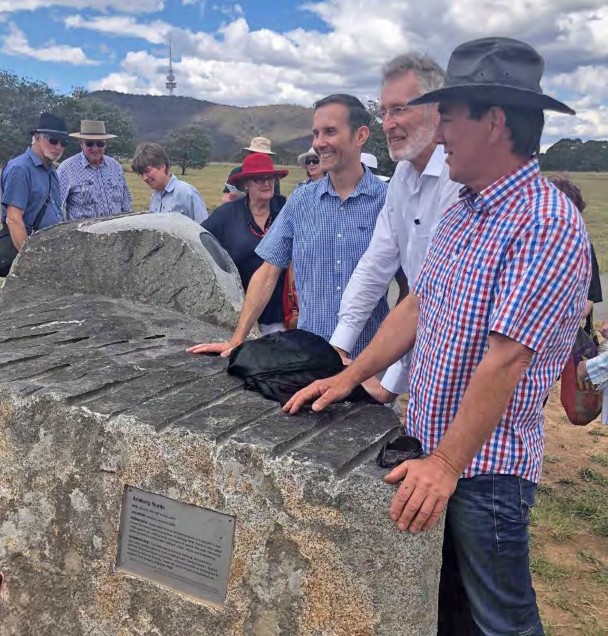

Author: Brad Pillans, Director, National Rock Garden
Extract from National Rock Garden Newsletter No. 18, October 2019
In late November 2018, we welcomed another rock to the National Rock Garden—a 9 tonne block of Adelong Norite, from the historic gold mining town of Adelong in the Snowy Mountains region of southern NSW.
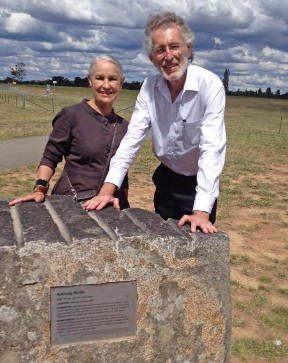
Norite, sometimes called black granite, is an uncommon type of mafic igneous rock. It is a very beautiful rock when cut and polished, as well as being very hard, so it is often used as a decorative building stone and for monuments and headstones in cemeteries. As it happens, the town of Adelong is built on a small norite intrusion of Silurian age—in fact it closely defines the urban area of the town—and for many years, small quarries operated within the town to supply decorative building and monumental stone. The quarries are now closed, but a number of large quarried blocks of norite remain. One of these blocks was donated to the NRG by Sheri McEvoy, on whose land the block was ‘resting’.
Adelong Norite was used to stunning effect as a decorative stone on the iconic Qantas House building which was opened in Sydney in 1957. I was also told that it was used in Old Parliament House in Canberra. However, when I visited there earlier this year, I could not find it. The interior of Old Parliament House features many different kinds of wood, sourced from all over Australia, but decorative stone is hard to find (admittedly, I didn’t check the bathrooms).
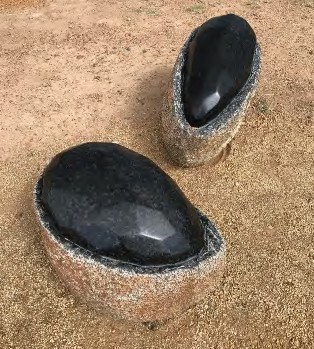
I therefore issued a challenge—next time you visit OPH, in Canberra, please help me find the Adelong Norite—and I offered a good bottle of wine to the first person who let me know where it was! [Note that norite also features in New Parliament House, but that rock was sourced from Black Hill in South Australia]. As it happened, Sheri McEvoy solved the mystery—Adelong Norite had been used in the NSW Parliament building in Sydney, but not in Canberra. We are currently following this up to confirm the details of its use!
In recent years, Adelong Norite has also been used by Austrian artist Andreas Buisman to create evocative rock sculptures, including a beautiful polished 9 tonne boulder that sits on the grave of the famous eye surgeon Fred Hollows (1929-1993), in the far western NSW town of Bourke—see Andreas’ story to learn more.
Andreas generously donated his time to partly sculpt the NRG specimen and has offered to do further work on the piece in due course. Bendigo Bank Adelong and the Snowy Valleys Council kindly provided funding to transport the rock from Adelong to the NRG. I particularly thank Stephanie Smyth (BBA) and Mayor James Hayes (SVC) for arranging this funding.
The inauguration ceremony for the Adelong Norite was held at the NRG on Sunday 25 November in perfect sunny weather, with 70–80 people attending. There was a late storm, but that arrived after the ceremony had finished.
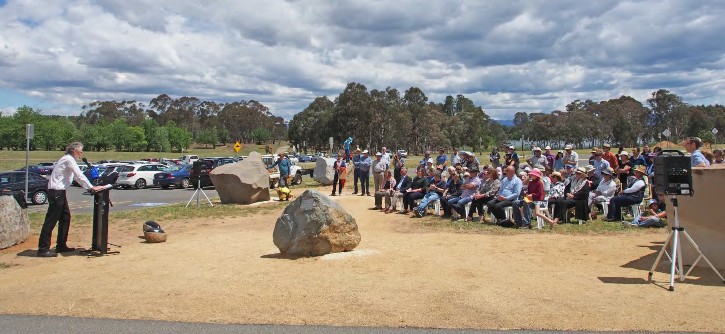
After an acknowledgement of country and some background comments on Adelong Norite, I introduced Andreas Buisman, who spoke passionately about the NRG concept and the need for funding the masterplan. ‘It’s not a lot of money, maybe 5 million dollars or so for the first stage’, said Andreas. The display was then opened by Suzanne Orr MLA, from the ACT government, after which she was presented with a copy of the weighty book, Shaping a Nation: A Geology of Australia, published by Geoscience Australia & ANU E Press.
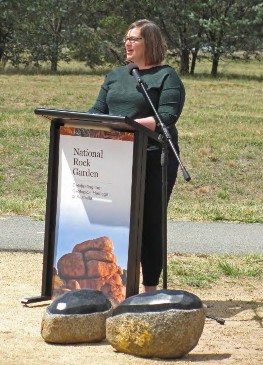
Given the Adelong link with Fred Hollows, it was great that Fred’s wife, Gabi, was able to attend, as well as the rock donor, Sheri McEvoy. We also had a surprise visit from Labor MP, Andrew Leigh, Shadow Assistant Treasurer and Shadow Minister for Charities and Not-for-Profits (Andrew’s office had previously advised that he had other commitments).
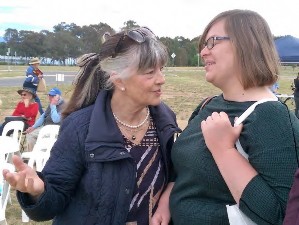
The day ended with a kid’s quiz organised by Ken McQueen – children (under 13 years old) were given a sheet with a series of rock garden questions to answer. The winner, whose parents just happened to be geologists, won a small gold nugget donated by Ken.
